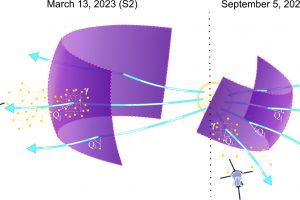First direct detection of relativistic particles accelerated in shocks in the heliosphere described in the study: “Direct Measurements of Synchrotron-emitting Electrons at Near-Sun Shocks” of I. C. Jebaraj (University of Turku)

In the Universe, various environments are characterized by shocks capable of converting the kinetic energy of gas and particle flows into heat, turbulence, magnetic energy, and, ultimately, accelerating particles to relativistic energies, producing cosmic rays. The sizes of these systems can vary by many orders of magnitude, ranging from the typical dimensions of the interplanetary environment to the enormous galaxy clusters. These mechanisms are primarily studied through the electromagnetic radiation emitted by highly energetic particles, particularly synchrotron radiation emitted by relativistic electrons moving along magnetic field lines in shock waves.
The physics of synchrotron emission and the connection between the spectral properties of this radiation and the physical characteristics of the system responsible for acceleration have long been subjects of study. Moreover, the scale invariance characterizing these processes (i.e., the preservation of properties and physical laws across different system scales) allows the study of shock waves produced in the heliosphere and interplanetary environment to provide insights into what happens in larger and more distant systems, such as supernova remnants, which are responsible for accelerating many galactic cosmic rays.
Local measurements of magnetic fields and synchrotron emission in the heliosphere are now possible thanks to NASA’s Parker Solar Probe, designed to make close passes to the Sun. On December 24, 2024, the probe reached a distance of 6.1 million km, moving at an astonishing speed of about 200 km/s. The research team led by astrophysicist I. C. Jebaraj (Department of Physics and Astronomy, University of Turku) analyzed data collected by the Parker Probe on September 5, 2022, and March 13, 2023. On these two days, the Parker Probe observed synchrotron emissions produced by particles accelerated in shock waves with different orientations between the directions of the magnetic field and the shock wave propagation: a “quasi-parallel” configuration on the first day and a “quasi-perpendicular” one on the second day.
The study shows how the different geometries of the shock waves are reflected in distinct characteristics of the synchrotron emission, such as its polarization, and in different efficiencies of particle acceleration, with higher efficiency observed in the “quasi-parallel” geometry. This confirms previous findings on the acceleration of cosmic rays in the supernova remnant SN 1006 based on X-ray observations. The Parker Probe data thus prove to be extremely important for understanding the physical processes that characterize the heliosphere and interplanetary environment, as well as those occurring in larger and more distant environments, such as supernova remnants.
The study is described in the article: “Direct Measurements of Synchrotron-emitting Electrons at Near-Sun Shocks“, recently published in The Astrophysical Journal. Among the co-authors is the astrophysicist M. Miceli from the University of Palermo, affiliated with INAF.
The cover illustration (click here to view it in full) shows a schematic configuration of the Parker Probe, the synchrotron emission, and the geometry of the shock waves and magnetic fields observed on the two days.
An interview to the main author of this paper is available here.
Mario Giuseppe Guarcello
Follow MarioSpiegaCose on Instagram () , Facebook (), Youtube (), and X ()
Follow the Astronomical Observatory of Palermo on Facebok and on Instagram
Subscribe the Youtube channel of the Astronomical Observatory of Palermo
